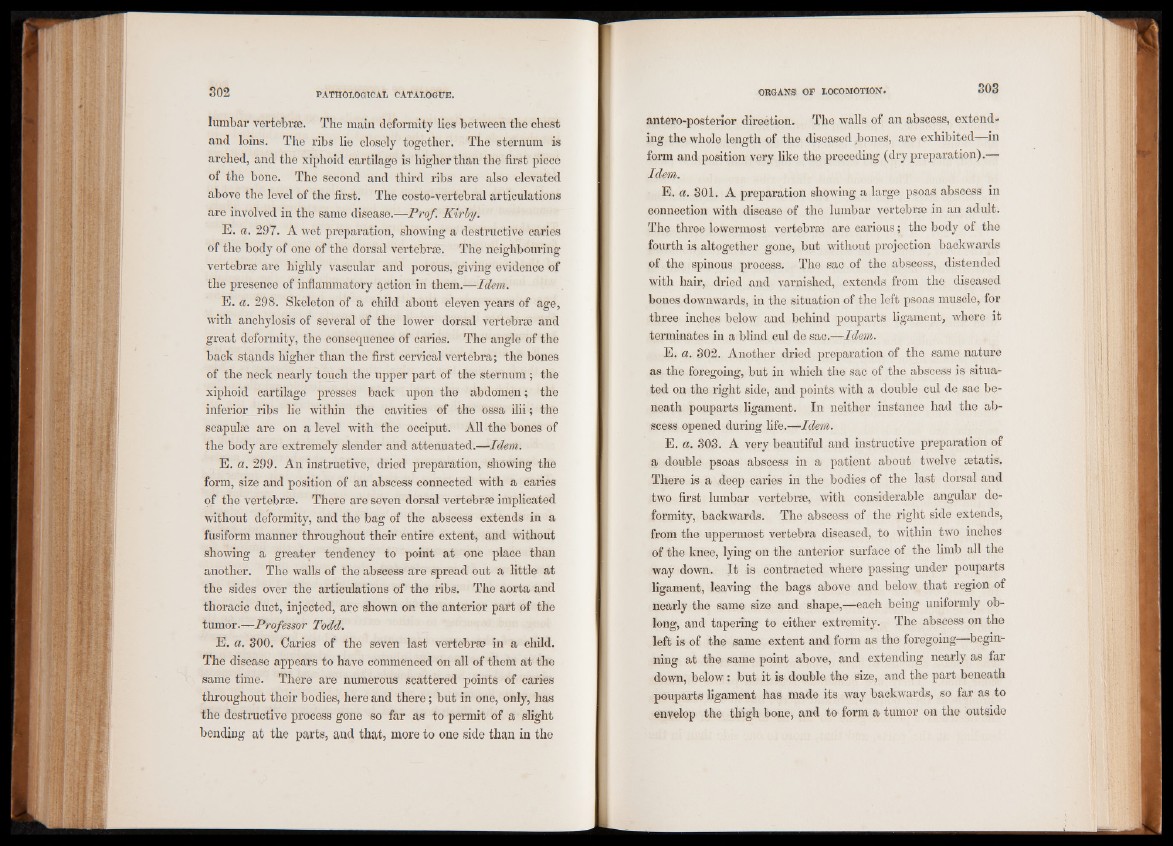
lumbar vertebrae. The main deformity lies between the chest
and loins. The ribs lie closely together. The sternum is
arched, and the xiphoid cartilage is higher than the first piece
of the bone. The second and third ribs are also elevated
above the level of the first. The costo-vertebral articulations
are involved in the same disease.—Prof. Kirby.
E. a. 297. A wet preparation, showing a destructive caries
of the body of one of the dorsal vertebrae. The neighbouring
vertebrae are highly vascular and porous, giving evidence of
the presence of inflammatory action in them.—Idem.
E. a. 298. Skeleton of a child about eleven years of age,
with anchylosis of several of the lower dorsal vertebrae and
great deformity, the consequence of caries. The angle of the
back stands higher than the first cervical vertebra; the bones
of the neck nearly touch the upper part of the sternum ; the
xiphoid cartilage presses back upon the abdomen; the
inferior ribs lie within the cavities of the Ossa ilii; the
scapulae are on a level with the occiput. All the bones of
the body are extremely slender and attenuated.—Idem.
E. a. 299. An instructive, dried preparation, showing the
form, size and position of an abscess connected with a caries
of the vertebrae. There are seven dorsal vertebrae implicated
without deformity, and the bag of the abscess extends in a
fusiform manner throughout their entire extent, and without
showing a greater tendency to point at one place than
another. The walls of the abscess are spread out a little at
the sides over the articulations of the ribs. The aorta and
thoracic duct, injected, are shown on the anterior part of the
tumor.—Professor Todd.
E. a. 300. Caries of the seven last vertebrae in a child.
The disease appears to have commenced on all of them at the
same time. There are numerous scattered points of caries
throughout their bodies, here and there; but in one, only, has
the destructive process gone so far as to permit of a slight
bending at the parts, and that, more to one side than in the
antero-posterior direction. The walls of an abscess, extending
the whole length of the diseased jbones, are exhibited—in
form and position very like the preceding (dry preparation).—
Idem.
E. a. 301. A preparation showing a large psoas abscess in
connection with disease of the lumbar vertebrae in an adult.
The three lowermost vertebrae are carious; the body of the
fourth is altogether gone, but without projection backwards
of the spinous process. The sac of the abscess, distended
with hair, dried and varnished, extends from the diseased
bones downwards, in the situation of the left psoas muscle, for
three inches below and behind pouparts ligament, where it
terminates in a blind cul de sac.—Idem.
E. a. 302. Another dried preparation of the same nature
as the foregoing, but in which the sac of the abscess is situated
on the right side, and points with a double cul de sac beneath
pouparts ligament. In neither instance had the abscess
opened during life.—Idem.
E. a. 303. A very beautiful and instructive preparation of
a double psoas abscess in a patient about twelve setatis.
There is a deep caries in the bodies of the last dorsal and
two first lumbar vertebrse, with considerable angular deformity,
backwards. The abscess of the right side extends,
from the uppermost vertebra diseased, to within two inches
of the knee, lying on the anterior surface of the limb all the
way down. It is contracted where passing under pouparts
ligament, leaving the bags above and below that region of
nearly the same size and shape,—each being uniformly oblong,
and tapering to either extremity. The abscess on the
left is of the same extent and form as the foregoing beginning
at the same point above, and extending nearly as far
down, below : but it is double the size, and the part beneath
pouparts ligament has made its way backwards, so far as to
envelop the thigh bone, and to form a tumor on the outside